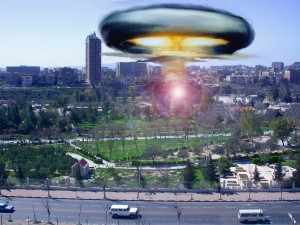Damascus gets Destroyed and Syrian Cities are Forsaken!
on Friday, June 14, 2013 by Bill Salus The ancient prophecy that predicts the total destruction of Damascus is the subject of considerable discussion among the prophecy buffs today with questions like:
The ancient prophecy that predicts the total destruction of Damascus is the subject of considerable discussion among the prophecy buffs today with questions like:
1.) Has this prophecy already been fulfilled?
2.) Who is responsible for the destruction of Damascus?
3.) How quickly will it happen?
4.) When will it happen?
5.) What is the scope of the destruction beyond Damascus?
Some scholars, like Dr. Mark Hitchcock, believe this prophecy already found fulfillment around 732 BC, shortly after it was presaged in Isaiah 17, when the Assyrians conquered Aram. Aram was the ancient name for much of modern day Syria.
But if it was fulfilled then, why did Jeremiah 49:23-27 predict a similar scenario about a century later? And, why did Isaiah mention Assyria 37 times throughout his 66 chapters, but never once mention it in Isaiah 17. For instance Isaiah 8:3-7 clearly identifies an Assyrian conquest of Damascus. This found fulfillment in Isaiah’s lifetime, but Damascus still exists today.
In my book, Psalm 83 – The Missing Prophecy Revealed, How Israel Becomes the Next Mideast Superpower, I provide an exhaustive commentary on Isaiah 17 in the chapter called “The Destruction of Damascus.” An abbreviated version of this teaching can be read under my follow up article called “Syria Under Siege; Concerns Bible Prophecy Experts!”
Also included in the Psalm 83 book is a second chapter that provides additional details about the destruction of Damascus, and it is called “The Destruction of Damascus Continued.” Because of the burgeoning concerns that Syria and Israel might soon become engaged in a major military confrontation, I am posting this secondary chapter about the doom of Damascus below.
This article answers some of the prophetic questions being asked about the future fate of Damascus. Three passages in Isaiah 17 deposit important details about who destroys Damascus and how quickly the city is toppled.
1.) The burden against Damascus. “Behold, Damascus will cease from being a city, And it will be a ruinous heap.” (Isaiah 17:1)
2.) In that day his [Damascus] strong cities will be as a forsaken bough And an uppermost branch, Which they left because of the children of Israel; And there will be desolation. (Isaiah 17:9)
3.) Then behold, at eventide, trouble! And [overnight] before the morning, he is no more. This is the portion of those who plunder us, [Israel] And the lot of those who rob us. (Isaiah 17:14)
Isaiah 17:1, 9, and 14, teach that Damascus will someday be reduced to a heap of rubble (verse 1) overnight, between some sunset and sunrise, because Damascus attempts to “plunder” and “rob” “the children of Israel,” (verse 14) who in return retaliate (verse 9). The Hebrew word used for both plunder and rob is bazaz. This dual usage infers that Syria, represented by its capital city Damascus, will be guilty of plundering and pillaging Israel.
The Isaiah 17:9 verse informs us that Syrians from “strong cities” are displaced. Isaiah predicts that Syrian cities, plural, will be as “a forsaken bough and an uppermost branch.” The bough of a tree is directly connected to its trunk, which implies that cities near Damascus are abandoned, but the uppermost branch reference suggests that cities in Northern Syria are also deserted. This probability is further addressed below in Jeremiah 49:23 concerning Hamath and Arpad.
The bottom line, according to Isaiah 17, is that Syria will experience widespread desolation, seemingly because they preemptively attempt to create desolation inside Israel. Damascus will be destroyed, leaving Syria with no capital city.
JEREMIAH’S BURDEN AGAINST DAMASCUS
Against Damascus [southern Syria]. “Hamath [northern Syria] and Arpad [northern Syria] are shamed, For they have heard bad news. They are fainthearted; There is trouble on the [Mediterranean] sea; It cannot be quiet. Damascus has grown feeble; She turns to flee [Syrian refugees], And fear has seized her. Anguish and sorrows have taken her like a woman in labor. Why is the city of praise [Jerusalem] not deserted, the city of My joy? Therefore her young men shall fall in her streets [Syrian civilian casualties], And all the men of war shall be cut off in that day [Syrian military casualties],” says the LORD of hosts. “I will kindle a fire in the wall of Damascus, And it shall consume the palaces of Ben-Hadad [Syrian capital buildings].” (Jeremiah 49:23-27).
The prophet points out that events inside Syria digress dramatically from bad to worse. The following tabulated bullet points below illustrate the gloomy destiny awaiting Damascus;
1. Bad News – becomes fainthearted,
2. There is trouble on the sea; It cannot be quiet,
3. The city has grown feeble,
4. She turns to flee,
5. Fear has seized her, like a woman in labor,
6. Her young men shall fall in her streets, (resulting in civilian casualties),
7. All the men of war shall be cut off, (resulting in military casualties and defeat),
8. The lord will kindle a fire and consume the palaces of Ben Hadad.
By connecting Jeremiah’s passage to Isaiah’s we get a grander picture surrounding the destruction of Damascus. Although some expositors teach that Jeremiah 49:23-27 found fulfillment during Jeremiah’s time through the Babylonian conquest over Damascus, clues in Jeremiah’s passage suggests otherwise. For instance, Jeremiah asks Damascus, “Why is the city of praise not deserted, the city of My joy?” This alludes to Jerusalem, which was destroyed and deserted during Jeremiah’s lifetime. Therefore, Jeremiah’s rhetorical question to Damascus about Jerusalem would prove pointless at the time.
Conversely, Jeremiah’s passage makes complete sense when aligned with Isaiah 17. For instance, Hamath and Arpad, two northern Syrian locations, are shamed because they receive troubling news. They become distressed along with Damascus, because they are all about to become battle zones.
These ancient cites, mentioned dozens of times in the Bible, historically ranked among the more important cities of Aram (modern-day Syria). Hamath is approximately 120 miles north of Damascus, and Arpad over 200 miles northeast of Damascus, about twenty-five miles north of today’s Aleppo. Therefore, when Isaiah 17:9 predicts Syria’s “strong cities will be as a forsaken bough And an uppermost branch,” we presume from Jeremiah’s descriptions the IDF’s retaliation against Syria will cause the abandonment of several formidable “strong” Syrian cities in addition to Damascus.
The trouble on the disquieted sea is a literal threat today, since Israel supposedly has nuclear weapons concealed in Dolphin class submarines off the Middle East coastline of the Mediterranean Sea. Perhaps some submarine launched missiles containing nuclear warheads could be launched toward Damascus by Israel from the Mediterranean. Could this be why Jeremiah says Damascus is seized by fear, grows feeble, and turns to flee as if anguished like a woman in labor? Is this why “young men shall fall in her streets, And all the men of war shall be cut off and the military defeated in that day?”
Notice Jeremiah predicts all the men of war, not a just a few troops, will be destroyed in this coming war. Presently the Syrian army is ranked 35th among world armies and includes many “young men” 18 and older.(i) Jeremiah’s prophecy causes us to consider the depths of Syria’s defeat. Furthermore, the young men he alludes to may include both civilians and military personnel. Certainly an assault that devastates an entire city like Damascus will cause much civilian loss of life. Consider the following information contained in the Encyclopedia of the Nations.(ii)
The population of Syria in 2003 was estimated by the United Nations at 17,800,000, which placed it as number 55 in population among the 193 nations of the world. In that year approximately 3% of the population was over 65 years of age, with another 41% of the population under 15 years of age. There were 102 males for every 100 females in the country in 2003. According to the UN, the annual population growth rate for 2000–2005 is 2.38%, with the projected population for the year 2015 at 23,018,000. The population density in 2002 was 95 per sq km (245 per sq mi), but most of it was concentrated in a small area; 70% of Syria’s people live in Damascus and the six western provinces.
Damascus is the capital of one of Israel’s main enemies and is a strategic target for Israel in the event of a multi-front war with Iran, Hezbollah, Hamas, and Syria. Syria is among the Arab countries that refuses to recognize Israel’s right to exist. They fought against Israel in 1948, 1967, and 1973. Unlike Jordan and Egypt, Syria has refused to make peace with Israel because it wants the Golan Heights returned, which Israel captured in 1967. Technically Syria is still at war with Israel and tensions between the two countries remain high.
On September 6, 2007, Israel attacked a suspected nuclear reactor in the Deir ez-Zor region of Syria as part of Operation Orchard. Threats and rumors of war have characterized the standoff between the two countries. In an interview with BBC TV on June 17, 2010, Syrian president Assad accused the reigning Israeli administration of Benjamin Netanyahu of being a “pyromaniac government,” and stated that there was no way to achieve peace with such a government.(iii) His comments came on the heels of the Mavi Marmara incident where nine Turkish activists died on a flotilla bound for Gaza.
A few months prior, in February of 2010, Israel’s blunt-talking foreign minister, Avigdor Lieberman, warned Syria’s president, Bashar al-Assad, that the Assad family would lose power in any war with Israel. In a speech at Bar-Ilan University, near Tel Aviv, Mr. Lieberman said: “I think that our message must be clear to Assad. In the next war, not only will you lose, you and your family will lose the regime. Neither you will remain in power, nor the Assad family.”(iv)
Even more recently these headlines have appeared concerning the rumors of war emanating between Israel and Syria.
‘If NATO attacks Syria, we’ll fire missiles at Tel Aviv’ – Jerusalem Post 10/4/11
Syria: Attack on military facility was a ‘declaration of war’ by Israel – CNN 5/6/13
Syria aims half-ton warhead missiles at Tel Aviv – Investment Watch 5/21/13
Syria’s arsenal includes the most advanced scud missiles in the world.(v) Additionally, Damascus is one of the closest major cities to Israel’s borders and could be used as a staging area for a ground and air attack into Israel given its ideal location between Iran to the east and Lebanon to the northwest.
Logically, if Israel comes under a multi-front attack from enemies possessing weapons of mass destruction, it will have to act aggressively, expeditiously, and decisively. Israel is the approximate size of the state of New Jersey, meaning a couple nuclear bombs could wipe the Jewish state off of the map. Israel doesn’t have the luxury of waging a war of attrition. It’s a matter of survival for the Jewish state and the destruction of Damascus by the IDF would indicate to its enemies that the war has become an all-or-nothing proposition.
………………..
((i))World army rankings taken as of 9/15/12 at this website on the Internet http://www.globalfirepower.com/
(ii)http://www.nationsencyclopedia.com/Asia-and-Oceania/Syria-POPULATION.html Information accessed over the Internet on 12/14/2010.
(iii)BBC interview with Syrian president Assad can be read on the Internet as of 9/4/11 at this link: http://www.bbc.co.uk/news/10337041
(iv)Lieberman quote gathered from the internet on 9/4/11 at this link: http://www.informationclearinghouse.info/article24599.htm
(v)Syrian Scud Missile potential gathered from a Prophecy Update Radio interview between white house correspondent Bill Koenig and the author, and can be heard as of 7/14/11 at this Internet link: http://isralestine-blog.blogspot.com/2011/07/big-squeeze-against-israel.html


